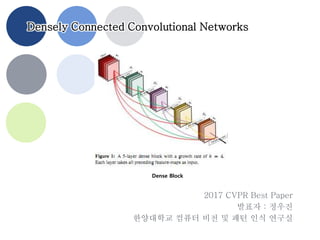
Review Dense net
- 1. Densely Connected Convolutional Networks 2017 CVPR Best Paper 발표자 : 정우진 한양대학교 컴퓨터 비전 및 패턴 인식 연구실 Dense Block
- 2. / 20 • Introduction • DenseNets • Experiments • Discussion • 주석 2 Contents
- 3. / 20 깊어지는 네트워크 • 깊이 = 성능 – LeNet5 5층 – VGG19 19 층 – ResNet 100~1000 • 깊은 네트워크의 문제 – 훈련이 어려움 이 논문에서 제안하는 방법 • Dense connection by concatenation • Feature map 의 깊이 늘리기 3 Introduction
- 4. / 20 Unit 구조 • Feature map의 깊이가 계속 깊 어지는 구조 4 DenseNets 참고 : Res unit
- 5. / 20 A Deep DenseNet • DenseNet의 한 예 • 분류기 5 DenseNets Transition Layer(전달층)
- 6. / 20 세부사항 • 기본 구조 – k = growth rate 매번 추가되는 깊이 • Bottleneck – Feature 압축 후 convolution – 연산량 감소 • 참고 : ResBlock 6 DenseNets BN Concat Conv 3x3 d:k ReLU BN Concat Conv 1x1 d:4k ReLU BN Conv 3x3 d:k ReLU BN Element-wise Sum Conv 3x3 ReLU BN Conv 3x3 ReLU
- 7. / 20 세부사항 • 압축 – 전달층에서 depth 압축 – 전달층 지날 때 𝜃 로 depth 축소 – 실험에서 𝜃 = 0.5 – 절반으로 감소 – 1x1 convolution 사용 – 연산량 감소 • DenseNet-BC – Bottleneck + 압축 7 DenseNets
- 9. / 20 ImageNet Dataset • ResNet과 비교 – parameters의 크기(네트워크 크기) 대비 성능 우수 – #flops(연산량 ∝ 1/속도) 대비 성능 우수 • 즉 네트워크의 학습이 더 쉽다. 9 Experiments
- 10. / 20 Model Compactness • Feature reuse = 같은 feature를 재학습 할 필요 없음 • 같은 성능 일 때 모델 크기가 작음 Implicit Deep Supervision • 암시적인 Supervision – Supervision = 매 층마다 loss를 계산하는 구조 10 Discussion
- 11. / 20 Feature Reuse • 넓은 범위로부터 데이터가 생성 – 초기 Feature를 남겨두는 것이 유용함 • Dense Block 2, 3에서는 일관 적으로 안 쓰는 데이터가 존재 – Bottelneck, 압축의 근거 • 마지막(DenseBlock3의 우측) 에서 가까운 층의 데이터를 집 중적으로 사용함 – 데이터 추상화 11 Discussion 보는 법 : 가로축(l) l번째 생성된 Feature 세로축(s) s번째 생성된 Feature 붉은색 : 관련된 Feature간 Conv. 가중치 절대값이 1 파란색 : Conv. 가중치 절대값이 0
- 12. / 20 DenseNets의 특징 장단점(1) • 저자의 관점 – Feature map은 한 단계의 상태를 저장한다고 가정 • 이유 – (X) Network는 하나의 덩어리 – (O) Network는 convolution층의 연합체 – 따라서 Feature map은 각 층의 상태를 저장, 그러므로 이전 단계의 결과 를 저장하는 것이 유용함 • 장점 – 기울기 소실에 대한 해결책 – Skip connection 의 한 종류 – 네트워크의 크기가 작아짐 – 암시적 Supervision – Supervision : 매 층마다 loss를 계산하는 네트워크 형태 12 주석
- 13. / 20 DenseNets의 특징 장단점(2) • 단점 – 깊어질 수록 depth가 늘어남 -> 연산량 증가 – Depth압축으로 해결 가능 13 주석
- 14. / 20 Feature Reuse • 일반적으로 convolution 층은 통과경로가 존재 • Feature reuse로 통과경로를 학습할 필요가 없음 14 주석